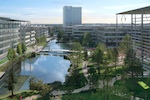ESPN casts its net wide
 You wait ages for a new building, then three come along at once. BBC Sport, Sky Sports and now ESPN have all moved into new buildings in the UK over the summer months. ESPN’s new offices might be the smallest but, as ever, the fledgling channel – on this side of the pond at least – has plans and is consistently punching above its weight.
You wait ages for a new building, then three come along at once. BBC Sport, Sky Sports and now ESPN have all moved into new buildings in the UK over the summer months. ESPN’s new offices might be the smallest but, as ever, the fledgling channel – on this side of the pond at least – has plans and is consistently punching above its weight.
One thing that you note is that it is very, very shiny. ESPN’s new offices are in Chiswick Park, a new development to the West of London between the centre of the city and Heathrow, that rejoices in the url of ww.enjoy-work.com and is trying very hard to live up to that promise. It’s not quite the campus atmosphere of the global giant’s Bristol Connecticut HQ, but it’s not too far off.
“It’s brighter, there’s sunlight…attitudes changed overnight,” says Steve Cozort, Director, Production Services & Operations.
While the broadcasters’ old offices were hardly pits of Stygian gloom, the new building is obviously a very nice environment to work in. It also helps the channel cement its own identity. It’s faired to say itwas dwarfed by parent company Disney in its old offices in Hammersmith, whereas here, even though it shares the building with Disney still, the numbers are much more in balance.
The move was completed in the last week of July, and if there are any boxes hanging round, that’s because new kit is arriving, not because the old stuff hasn’t been unpacked yet. While several aspects of a broadcaster’s daily duties are still off-site – studios remain with IMG, playout is handled by Arqiva etc – they’ve managed to fit a lot into the building, including seven craft suites running FCP, QC rooms, IPTV control and, of course, ESPN.net, the company’s fibre link to ESPNs around the world.
“We didn’t realise the potential of ESPN.net at first.” admits Head of Channels ESPN EMEA, Jeroen Oerlemans frankly. “This group, for instance, has already done 1100 feeds that were not generated by us. Someone from our group downlinks a feed, say Serie A football. They take a clean feed, put ESPN graphics on it, put an English language commentary on it, and it goes out on ESPN net. If you’re a rights holder [linked to us], you can then just put it out; you don’t have any additional technical costs.
Oerlemans highlights a recent deal with an Argentinian broadcaster to show Aviva Premiership Rugby from the UK, which will just see them take ESPN’s full coverage piped down the fibre with no intervention required on ESPN”s part.
“ESPN.net is something we have over our competition,” adds Cozort. “It’s opened up doors that we didn’t know were there. We’re now connected all the way to Singapore. Even the guys in Connecticut that designed this had no idea it would open up the company the way it has.”
And there’s no intention of resting on their fibre laurels either. A close inspection of a stack of large cardboard boxes just outside Cozort’s office reveals the stamp of a certain well-known broadcast manufacturer.
“We’ve also just purchased a major system from a manufacturer that will enable us to share even more content back and forth across the pond with Bristol,” says Cozort. “My main objective while I’m here is to give the productions as many of the capabilities they have in the States at their fingertips as possible. The e-tools that they use in the States are going to be extended over here through the ESPN net, that little piece of fibre stretched between here and Connecticut, for very little capital expenditure.
“The guys and gals here will be able to tap into the library system and peruse the drives and the SANS in Connecticut, and vice versa. We still have to flip it from 720 to 1080 and there’s a bit of QCing that has to go on, but the transcoding doesn’t take that long to do.”
It might only be located in a relatively small office on the road out to Heathrow, but ESPN.net allows it to be instantaneously part of the global behemoth that is ESPN. And it’s only a small office at the moment too. “We could use a bit more space here, but there are always opportunities,” says Oerlemans. “We can then start figuring out what we want to do with playout and transmission, our studio, our archive…it’s a process for the longer term.”
